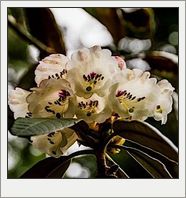Primary tabs
GETTING STARTED WITH RHODODENDRONS
Rhododendron - a plant for all seasons, a plant for all locations. But which plant? When you're at that in-between stage in life, where you no longer are satisfied with buying something on the basis of big red flowers and feel it's time to start selecting your plant based on discriminating criteria (which you haven't yet had time to develop), you might be tempted to throw in the trowel. Do not despair, dear reader, but consider the following helpful hints to start you on the way towards developing a collection that in a few short years you'll proudly be showing slides of to all your friends and relations. (n.b. all plants mentioned are generally available locally).
Rule number one - flowers last but a few short days and you will be looking at the plant itself for many, many more. Go for a good-looking plant. You can't go wrong with a yak(ushimanum) or any of the hybrids in its family - 'Pirouette', the seven dwarfs ('Hoppy', 'Dopey' etc, - I kid you not), 'Coral Velvet', R. yak. x 'Corona', 'Yaku Fairy'. What's more, they all have pretty terrific flowers. The noble 'Sir Charles Lemon' has beautiful foliage and eventually becomes a lovely small tree. Others worth looking for are 'Golfer', R. pachysanthum, R.pseudochrysanthum and, as one noted grower puts it, the Rolls Royce of foliage - R. campanulatum aeruginosum.
Rule number two - keep it simple. Don't set your heart on a plant that isn't available locally or is a known prima-donna. There are so many others which would make you even happier. 'PJM' is a do'er: a medium-sized plant with aromatic foliage and bright flowers, it always looks good. Another easy-to-grow plant is 'Dora Amateis' - a vision in white. If you'd like a larger-growing plant, 'The Honourable Jean Marie de Montague' is a good solid red. For something smaller, try R.impeditum, a tight bush of vibrant blue.
Rule number three - do some research; it's fun. A combination of walks in a well-labelled garden and browsing through books will do the trick. For the former, Van Dusen Gardens and UBC's David Lam Asian Garden are the obvious winners. Then get yourself at the very least a Greer Garden's catalogue, preferably a Greer's Guide. The Cox booksare the next step up and well worth it, being more scholarly and with carefuly considered evaluations. And make use of the libraries - borrow a different book from each one and soon you'll be an expert! A note for the new century - use the internet. Good local sites are springing up everywhere.
Rule number four - choose a plant that is at its best when YOU are in the garden. If you spend every June in Provence, no sense filling your garden with the late-blooming R. ariculatum hybrids and Exbury azaleas and then missing them when they're in their glory. But if you don't even venture outdoors till bathing-suit weather, then these are the plants for you. The hardy souls who use their gardens for a quick winter pick me-up (or would place these plants right outside their windows) might consider some early-bloomers. 'Snow Lady', 'Mary Fleming' and R. moupinense are all pale beauties. Try 'Olive' if you like sizzling colours, or 'Christmas Cheer', R. dauricum and R.pemakoense for something in-between.
Rule number five - ask the experts. Gardeners, and Master Gardeners especially, like to talk about their plants even more than they like growing them! So go to the Van Dusen Plant Sale, Rhododendron Society shows and sales, Master Gardener clinics. They provide opportunities to learn from those in the know and perhaps also acquire some choice specimens.
Rule number six - indulge your fancy. Don't think that there are some ultimate criteria for what's the 'right' plants to grow. If you like purple (I'm wild about it), grow every shade of it. There are many named cultivars of R. augustinii which gave every shade of blue/purple. My very first plants were 'Fastuosum Flore Pleno', 'Bob's Blue' and R.impeditum. They're still flourishing and blend quite nicely together. Or go for fragrance - 'Loderi King George' and other Loderi hybrids, 'Exbury Naomi', 'Angelo' - all are heavenly. And so many of the deciduous azaleas are fragrant - 'Daviesi', 'Orchid Lights' (& the rest of the Northern Lights series), 'Jolie Madame', 'Oxydol' , 'Arpege' (obviously). And don't forget 'Windbeam' or 'PJM' for fragrant foliage.
Rule number seven - if something does well in your garden, get more like it. If you have nothing but sun, go for azaleas rather than the broad-leafed rhododendrons, which prefer some protection. If a R.williamsianum hybrid flourishes in your soil, it has enough friends and relations ('Wilbrit', 'Linda', 'Bow Bells', 'Karin', 'Moonstone',etc.) that you can appear to have lots of variety while staying within a narrow range.
Rule number eight - don't ever get discouraged by adversity. The experts lose plants occasionally; you will too. Look upon these losses as an opportunity to acquire a new replacement plant. That leads to...
Rule number nine - don't throw good money after bad. If 'Purple Splendour' dies on you twice, forget it. Some plants are just not meant to be grown in certain gardens. Try 'Anah Kruschke' instead - it's much easier to grow and a better-looking plant. Or go for a different style, but much better colour, the small flowers of 'Vibrant Violet'.
Rule number ten - take a chance. Use the opportunity to get young, inexpensive plants at the sales and grow them along. They'll have a better chance of making it if they do their growing in your garden.If they don't turn out to be what you had if mind, they're easily disposed of. And some 'Unknown Warrior' might turn out to be the love of your (gardening) life!

